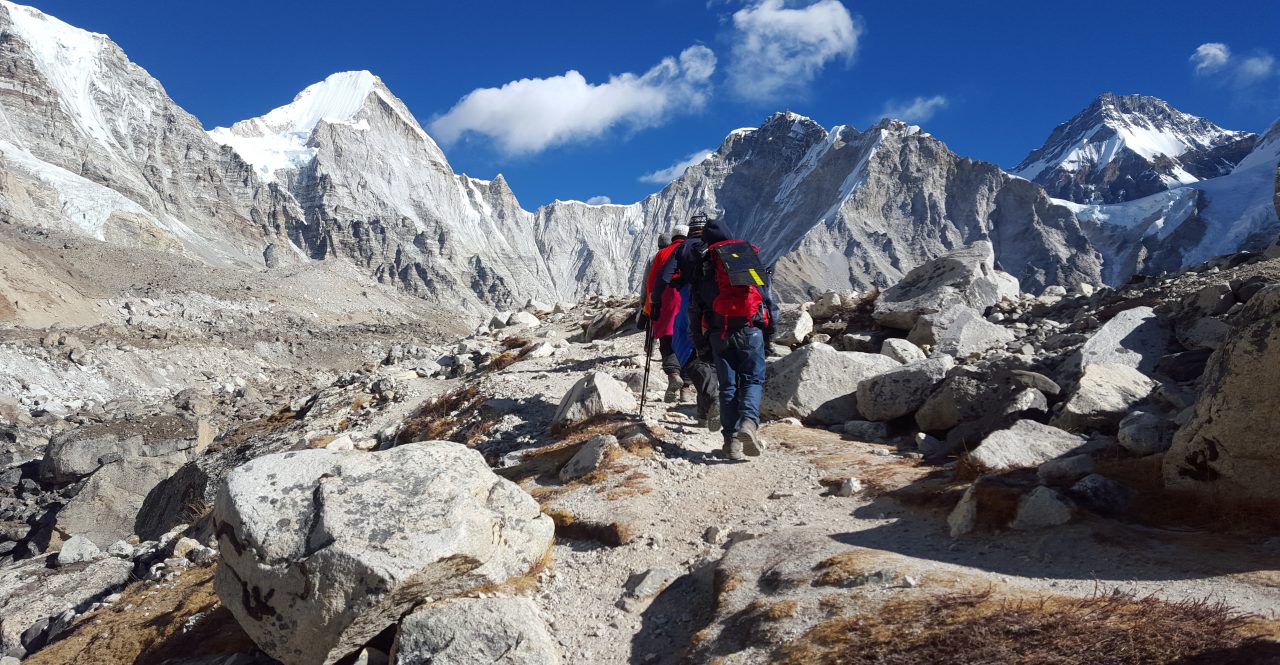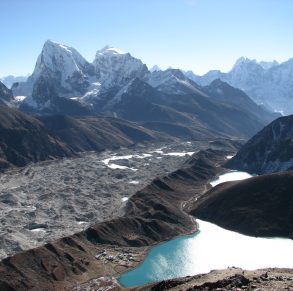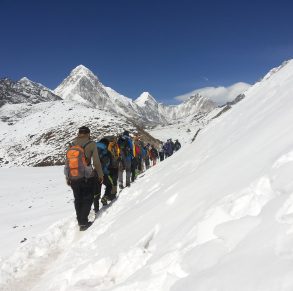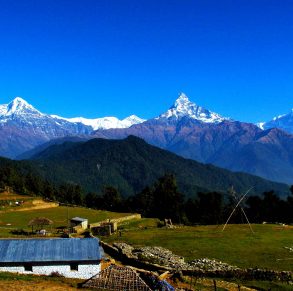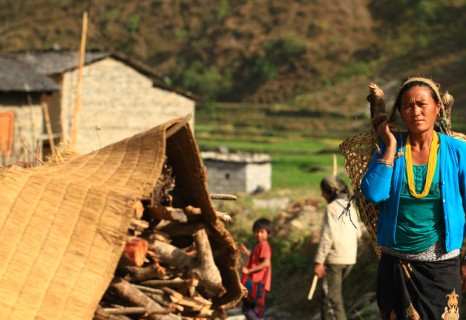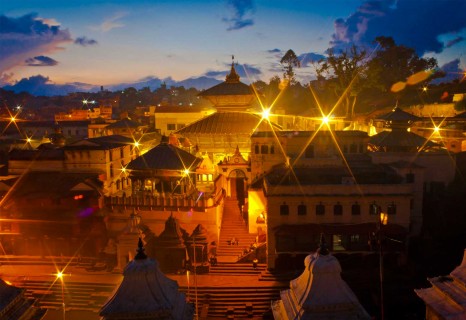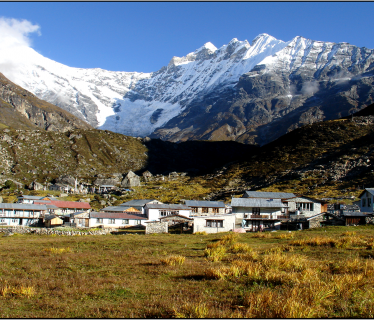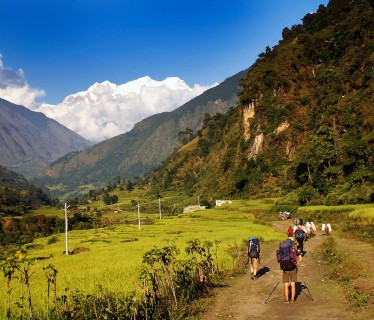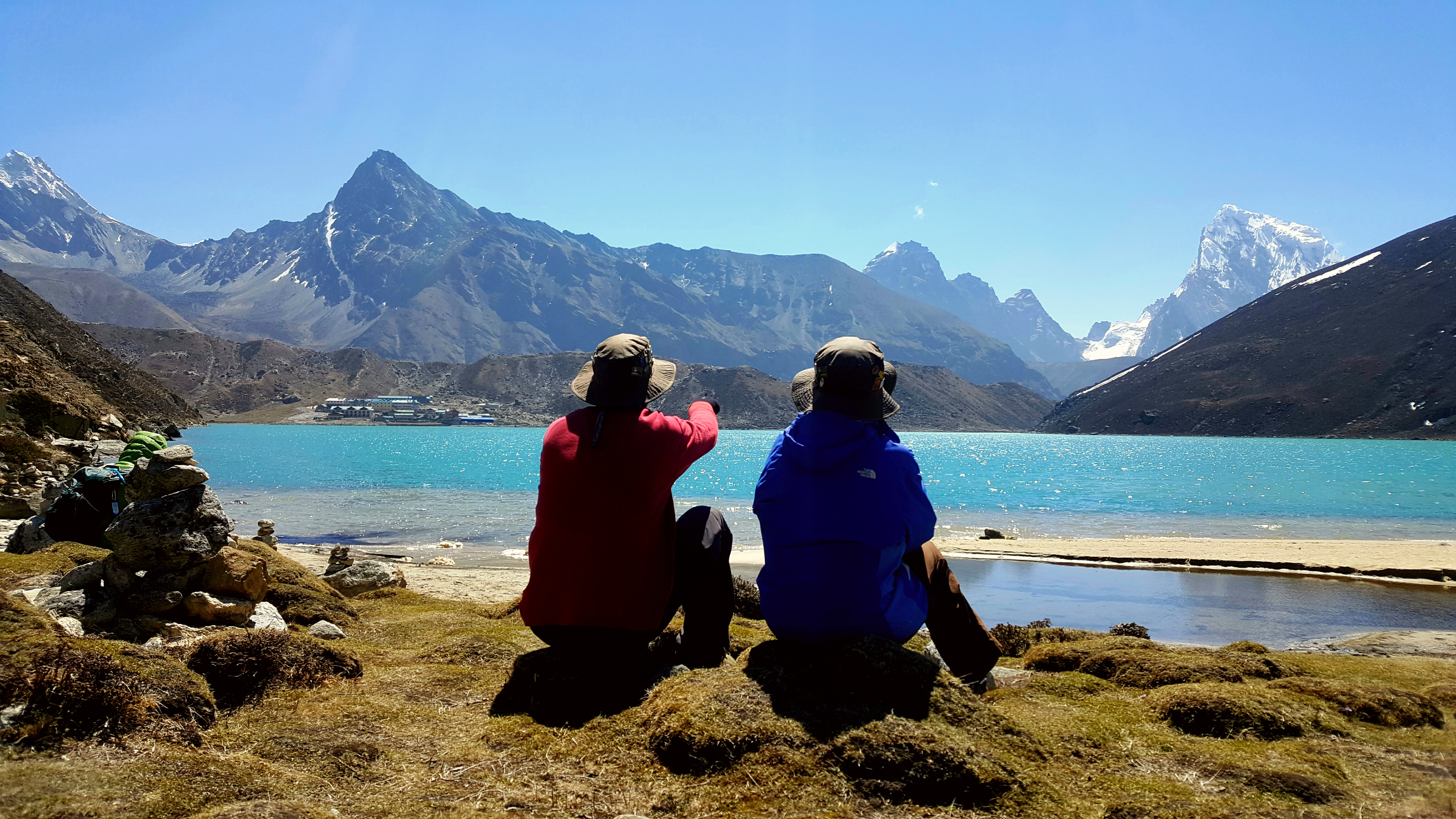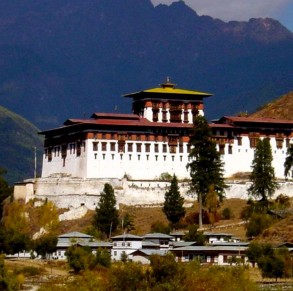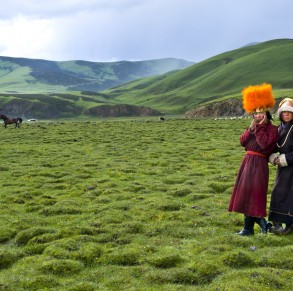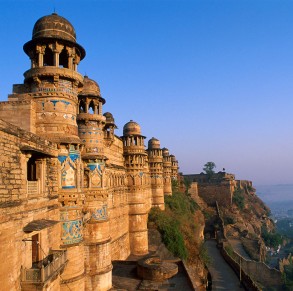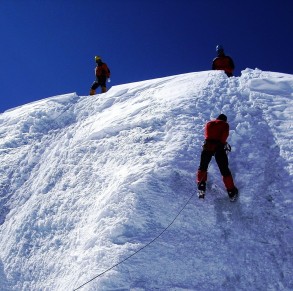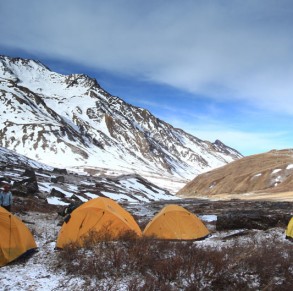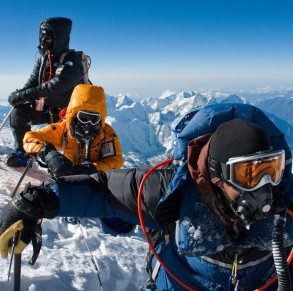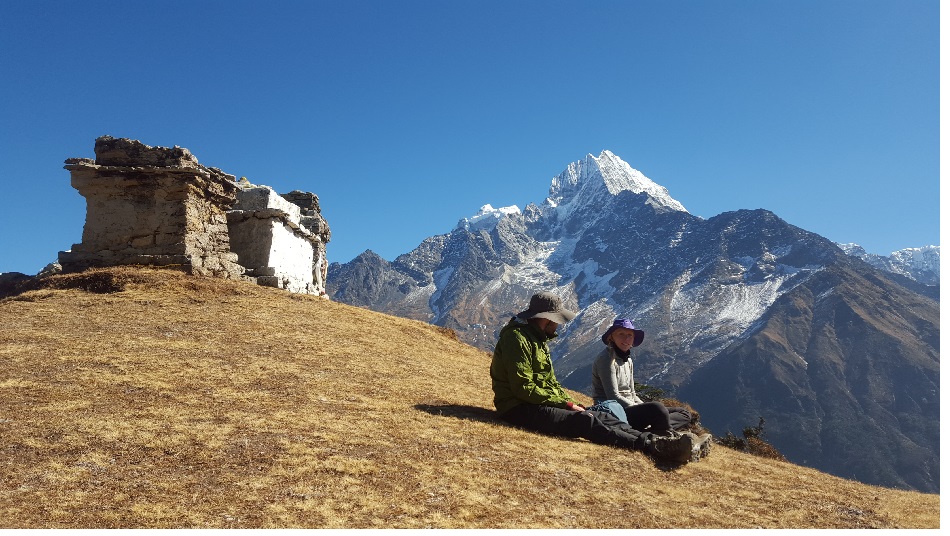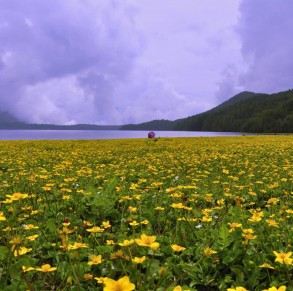Day 01: Kathmandu/Lukla by flight. Trek to Phakding (2610 m.)
Day 02 : Phakding to Namche (3440 m.)
Day 03: Acclimatization day in Namche
Day 04: Namche to Tengboche (3837 m.)
Day 05: Tengboche to Dingboche (4350 m.)
Day 06: Dingboche to Lobuche (4930 m.)
Day 07: Lobuche to Everest base camp(5364 m.) and to Gorakshep (5160 m.)
Day 08: Visit Kalapatthar and trek to Lobuche (4930 m.)
Day 09: Lobuche to Dingboche (4350 m.)
Day 10: Dingboche toTengboche (3837 m.)
Day 11: Tengboche to Namche (3440 m.)
Day 12: Namche to Lukla (2860 m.)
Day 13: Lukla/ Kathmandu by flight. Overnight at hotel in Kathmandu.
Day 01: Kathmandu/Lukla by flight. Trek to Phakding (2610 m.)
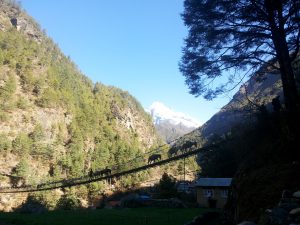 After breakfast, we will be escorted to the domestic terminal of Kathmandu airport for an early morning flight to Lukla (2,800 m/9,186 ft), a gateway destination from where our trek begins. After an adventurous 40 minute flight above the breathtaking green and white mountains, we reach the Tenzing-Hillary Airport at Lukla. This is one of the most beautiful air routes in the world culminating in a dramatic landing on a hillside surrounded by high mountains peaks. Upon arrival at Lukla, we meet our other crew members and after some packing and arrangements, we start our trek through the prosperous village of Lukla until we reach Phakding. To assist in acclimatization, we only have a short hike today. However, if interested in additional activities we can take a side trip to a nearby monastery
After breakfast, we will be escorted to the domestic terminal of Kathmandu airport for an early morning flight to Lukla (2,800 m/9,186 ft), a gateway destination from where our trek begins. After an adventurous 40 minute flight above the breathtaking green and white mountains, we reach the Tenzing-Hillary Airport at Lukla. This is one of the most beautiful air routes in the world culminating in a dramatic landing on a hillside surrounded by high mountains peaks. Upon arrival at Lukla, we meet our other crew members and after some packing and arrangements, we start our trek through the prosperous village of Lukla until we reach Phakding. To assist in acclimatization, we only have a short hike today. However, if interested in additional activities we can take a side trip to a nearby monastery
Day 02 : Phakding to Namche (3440 m.)
 After breakfast in Phakding, we commence our trek to Namche Bazaar.The trail follows the right bank of the Dudh Koshi river. Today we will enter the Sagarmatha National Park, a conservation area that encompasses the entire Khumbu region. You will also get views of Mt. Thamserku, Everest (8848m) and Lhotse (8516m.). After a steep two hour climb, you will reach Namche Bazaar, which is surrounded on three sides by mountain ranges. Namche is a central hub of the Everest area and also a major trading village for food, trekking gears and other necessary goods. From historical time till today, Tibetans make the arduous journey crossing the Nangpala pass to trade in Namche.
After breakfast in Phakding, we commence our trek to Namche Bazaar.The trail follows the right bank of the Dudh Koshi river. Today we will enter the Sagarmatha National Park, a conservation area that encompasses the entire Khumbu region. You will also get views of Mt. Thamserku, Everest (8848m) and Lhotse (8516m.). After a steep two hour climb, you will reach Namche Bazaar, which is surrounded on three sides by mountain ranges. Namche is a central hub of the Everest area and also a major trading village for food, trekking gears and other necessary goods. From historical time till today, Tibetans make the arduous journey crossing the Nangpala pass to trade in Namche.
Day 03: Acclimatization day in Namche
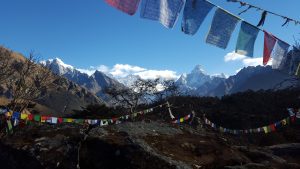 Acclimatization is important before proceeding higher. At this point, we take a well-deserved break! Today will be spent resting and allowing our bodies to become acclimatized to the lofty altitude. There’s an optional 2 hour hike to Everest View Point, an uphill walk that will help speed acclimatization. Otherwise, spend the day exploring Namche Bazaar. Check out the Sherpa museum for an overview of the Sherpa culture and history of mountaineering. On Saturdays, the Hatt Bazaar is open for trading and an intimate look at the locals’ marketplace. It is part of the larger Namche Bazaar, a shopping hub filled with all manner of trekking and mountaineering clothing and equipment.
Acclimatization is important before proceeding higher. At this point, we take a well-deserved break! Today will be spent resting and allowing our bodies to become acclimatized to the lofty altitude. There’s an optional 2 hour hike to Everest View Point, an uphill walk that will help speed acclimatization. Otherwise, spend the day exploring Namche Bazaar. Check out the Sherpa museum for an overview of the Sherpa culture and history of mountaineering. On Saturdays, the Hatt Bazaar is open for trading and an intimate look at the locals’ marketplace. It is part of the larger Namche Bazaar, a shopping hub filled with all manner of trekking and mountaineering clothing and equipment.
Day 04: Namche to Tengboche (3837 m.)
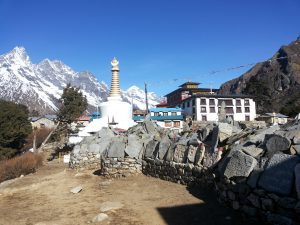 Upon breakfast in Namche, we set out towards Tengboche, enjoying superb view of Mt. Everest, Mt. Nuptse, Mt. Lhotse, Mt. Ama Dablam and close up view of Thamserku. Our trek follows more or less smooth trail with few ups and downs which will not bother us as the magnificent view of the Himalayas keeps our company all through the journey. Along the way, we can spot wildlife musk deer, a herd of Himalayan Thar and multicolored pheasants. The trail goes gradually down up to Kayangjuma. The path eventually reaches Sansa, which is the major trail junction to Gokyo valley and Everest Base Camp. The track then follows through the pine forests and after we cross the prayer flags festooned bridge over the Dudh Koshi River, we reach Phunki Thenga, a small settlement with a couple of teahouses and a small army post amidst the alpine woods. After having a relaxed lunch at Phunki Thenga, we gear up for a slightly tougher climb through the pine forests before we reach Tengboche. Tengboche is a great place for close up views of Mt Ama Dablam, Mt Nuptse, and Mt Everest, and it has the biggest Buddhist Monastery of the Khumbu region. We pay our visit to the monastery the same day at around 3 pm to witness the ceremony in the principal and popular monastery of Everest region. Overnight stay at a lodge at Tengboche.
Upon breakfast in Namche, we set out towards Tengboche, enjoying superb view of Mt. Everest, Mt. Nuptse, Mt. Lhotse, Mt. Ama Dablam and close up view of Thamserku. Our trek follows more or less smooth trail with few ups and downs which will not bother us as the magnificent view of the Himalayas keeps our company all through the journey. Along the way, we can spot wildlife musk deer, a herd of Himalayan Thar and multicolored pheasants. The trail goes gradually down up to Kayangjuma. The path eventually reaches Sansa, which is the major trail junction to Gokyo valley and Everest Base Camp. The track then follows through the pine forests and after we cross the prayer flags festooned bridge over the Dudh Koshi River, we reach Phunki Thenga, a small settlement with a couple of teahouses and a small army post amidst the alpine woods. After having a relaxed lunch at Phunki Thenga, we gear up for a slightly tougher climb through the pine forests before we reach Tengboche. Tengboche is a great place for close up views of Mt Ama Dablam, Mt Nuptse, and Mt Everest, and it has the biggest Buddhist Monastery of the Khumbu region. We pay our visit to the monastery the same day at around 3 pm to witness the ceremony in the principal and popular monastery of Everest region. Overnight stay at a lodge at Tengboche.
Day 05: Tengboche to Dingboche (4350 m.)
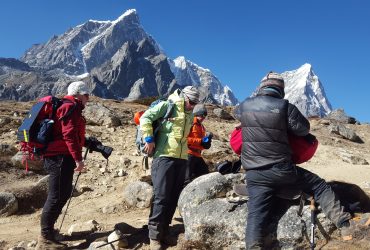 With mountains at its backdrop, the monastery at Tengboche looks more spectacular in the morning. At this juncture, we can take pictures of the monastery and the scenery around and as usual start the day journey. We choose the upper trail for better views on the way to Pangboche village. We pass through several Chortens and Mani walls and small villages. The place where we stop for lunch not only serves delicious food but also allows a fantastic close-up view of Mt Ama Dablam. In the afternoon, we walk north to Pheriche or take the eastward trail beneath the towering north face of Mt Ama Dablam. From here onwards, the walk is fairly moderate as we enter the Imja Valley. The valley gradually unfolds as we approach the confluence of the Lobuche River. We descend into the river and begin the last and steepest climb of the day up to Dingboche. On arrival at Dingboche, we will see beautiful array of fields enclosed by stone walls to protect barley, buckwheat and potatoes from the cold winds and grazing animals. Overnight at Dingboche.
With mountains at its backdrop, the monastery at Tengboche looks more spectacular in the morning. At this juncture, we can take pictures of the monastery and the scenery around and as usual start the day journey. We choose the upper trail for better views on the way to Pangboche village. We pass through several Chortens and Mani walls and small villages. The place where we stop for lunch not only serves delicious food but also allows a fantastic close-up view of Mt Ama Dablam. In the afternoon, we walk north to Pheriche or take the eastward trail beneath the towering north face of Mt Ama Dablam. From here onwards, the walk is fairly moderate as we enter the Imja Valley. The valley gradually unfolds as we approach the confluence of the Lobuche River. We descend into the river and begin the last and steepest climb of the day up to Dingboche. On arrival at Dingboche, we will see beautiful array of fields enclosed by stone walls to protect barley, buckwheat and potatoes from the cold winds and grazing animals. Overnight at Dingboche.
Day 06: Dingboche to Lobuche (4930 m.)
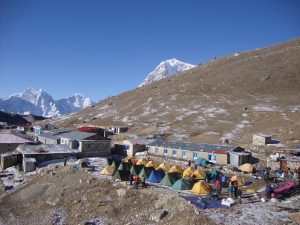 The trail climbs to Duglha at 4620m. From Dughla the trail ascends the broad, gently slopping valley and climbs steeply in to the terminal moraine of the Khumbu glacier then left in to the memorial area for people that passed away in the Everest Expedition at Chukpilhara, before reaching Lobuche (4930 m).
The trail climbs to Duglha at 4620m. From Dughla the trail ascends the broad, gently slopping valley and climbs steeply in to the terminal moraine of the Khumbu glacier then left in to the memorial area for people that passed away in the Everest Expedition at Chukpilhara, before reaching Lobuche (4930 m).
Day 07: Lobuche to Everest base camp(5364 m.) and to Gorakshep (5160 m.)
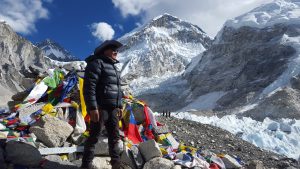 The trail is pretty easy to start with other than the fact we will be height almost at 5000 m. We then started to gradually ascend following the Khumbu glacier up the valley to Lobuche pass. Then there was a steep section then a series of rocky and icy ups and downs. As the sun began to rise, its rays quickly warmed us up, allowing us to move a bit more freely when taking on the next rocky scramble. A short descent brought us to Gorakshep (5160 m.) which is the last village before base camp and our highest sleeping altitude of the trek. Early morning we walk to Everest Base Camp, visit base camp area and walk down to Lobuche. From the Everest Base Camp you can see the north face of Mt. Everest, the famous Khumbu Ice Fall, Lhotse and Nuptse.
The trail is pretty easy to start with other than the fact we will be height almost at 5000 m. We then started to gradually ascend following the Khumbu glacier up the valley to Lobuche pass. Then there was a steep section then a series of rocky and icy ups and downs. As the sun began to rise, its rays quickly warmed us up, allowing us to move a bit more freely when taking on the next rocky scramble. A short descent brought us to Gorakshep (5160 m.) which is the last village before base camp and our highest sleeping altitude of the trek. Early morning we walk to Everest Base Camp, visit base camp area and walk down to Lobuche. From the Everest Base Camp you can see the north face of Mt. Everest, the famous Khumbu Ice Fall, Lhotse and Nuptse.
Day 08: Visit Kalapatthar and trek to Lobuche (4930 m.)
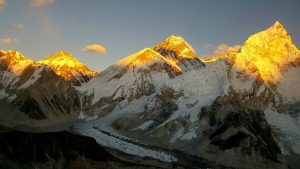 Early morning, climb 2-3 hrs. up to Kala Patthar (5545 m/18192 ft) to see first day sun light from top of the world (Mt. Everest). Meaning ‘black rock’ in English, Kala Patthar stands at an impressive 5,644 m above sea level, making it the highest altitude reached on most EBC treks at over 300 m above Everest Base Camp. Its name comes from the coloration of the rock that make up its peak – a dark black that stands in stark contrast to the snow-capped peaks it surveys. This is milestone of the trek to inspect panoramic view with the fantastic sunrise over Mt. Everest, Mt. Pumori, Mt. Lingtren, Khumbutse, Changtse, Mt. Lhotse, Mt. Nupte, Mt. Ama Dablam and many more.
Early morning, climb 2-3 hrs. up to Kala Patthar (5545 m/18192 ft) to see first day sun light from top of the world (Mt. Everest). Meaning ‘black rock’ in English, Kala Patthar stands at an impressive 5,644 m above sea level, making it the highest altitude reached on most EBC treks at over 300 m above Everest Base Camp. Its name comes from the coloration of the rock that make up its peak – a dark black that stands in stark contrast to the snow-capped peaks it surveys. This is milestone of the trek to inspect panoramic view with the fantastic sunrise over Mt. Everest, Mt. Pumori, Mt. Lingtren, Khumbutse, Changtse, Mt. Lhotse, Mt. Nupte, Mt. Ama Dablam and many more.
After accomplish Kala Patthar, trek down to Gorakshep and retrace down to Lobuche to the warmer and better night sleep. Overnight in Lobuche.
Day 09: Lobuche to Dingboche (4350 m.)
And after making a descend walk for around 5 hours you arrive at Dingboche. Which is incidentally, is the only place in Khumbu where barly is grown.
Day 10: Dingboche to Tengboche (3837 m.)
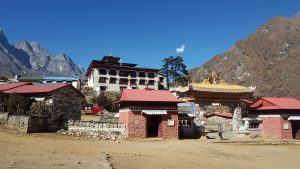 Today we make a descend walk for 5 hours to arrive at Tengboche. We do overnight at Tengboche.
Today we make a descend walk for 5 hours to arrive at Tengboche. We do overnight at Tengboche.
Day 11: Tengboche to Namche (3440 m.)
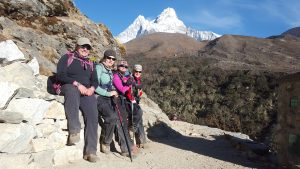 The walk from Tengboche to Namche is relatively straight and downhill and takes around 5-6 hours. There is a monastery at Thamo and Sherpa villages in between.
The walk from Tengboche to Namche is relatively straight and downhill and takes around 5-6 hours. There is a monastery at Thamo and Sherpa villages in between.
Day 12: Namche to Lukla (2860 m.)
This is the last day of the trek and there is plenty of downhill walk from Namche Bazaar to Lukla.
Day 13: Lukla/ Kathmandu by flight. Overnight at hotel in Kathmandu.
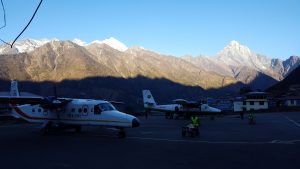 We board our early flight from Lukla to Kathmandu. Upon arrival at Kathmandu you will be received by a Snow Leopard Trek representative and transferred to your hotel. Rest day free in Kathmandu for shopping and relax.
We board our early flight from Lukla to Kathmandu. Upon arrival at Kathmandu you will be received by a Snow Leopard Trek representative and transferred to your hotel. Rest day free in Kathmandu for shopping and relax.



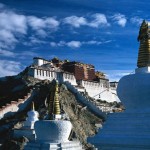
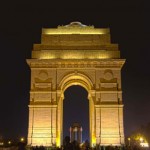

 Español
Español